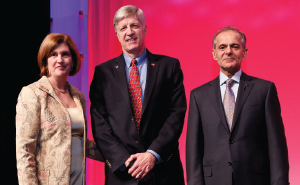
2016 ACR President Joan Van Feldt, MD, MSEd (L), and 2017 ACR President Sharad Lakhanpal, MBBS, MD (R), present Dr. O’Dell with the 2016 ACR Distinguished Clinical Investigator Award.
When it was created in 1982, the Division of Rheumatology and Immunology at the University of Nebraska Medical Center comprised one-and-a-half rheumatologists: its founder, Lynell W. Klassen, MD, MACR, and Gerald Moore, MD, who later received formal training at the NIH and now serves as senior associate dean for academic affairs.
Thirty-five years later, the division has 13 faculty members and is internationally recognized for its expertise and depth of research resources, with an emphasis on investigator-initiated clinical trials, registries and biobanks. Among the award-winning faculty, the commitment to and enthusiasm for teamwork, research and teaching is palpable. Ted R. Mikuls, MD, MSPH, Umbach Professor of Rheumatology, who did his fellowship at the University of Alabama in Birmingham before returning to his alma mater, notes, “Everyone is here because they want to be here. We’re all rowing the same boat together. It really is a team in every sense of the word.”
Studies with the Patient in Mind
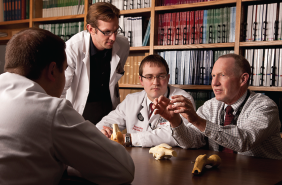
Dr. Gerald Moore teaches residents and students.
In addition to his duties as division chief, James O’Dell, MD, serves as residency program director for the Department of Internal Medicine at UNMC. He is also former president of the ACR (2012) and the Rheumatology Research Foundation (2007). He founded the Rheumatoid Arthritis Investigational Network (RAIN) shortly before becoming division chief in 1990.
During his fellowship in rheumatology research at the University of Colorado Health Sciences Center, Dr. O’Dell had been involved with a pivotal methotrexate trial for RA. His idea at UNMC was to reach out to community providers to build substantial patient enrollment numbers and to foster a sense of ownership in the trial design.
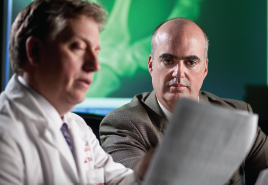
Dr. Alan R. Erickson and Dr. Ted R. Mikuls review data.
“RAIN was put together because we wanted to address questions that were clinically important,” he recalls. “We asked physicians in private practice to help us design a trial that had the patient in mind. One example of this was not treating people with placebos when treatments were available.”
One of the landmark studies emanating from that approach, known colloquially as the triple one study, was published in the New England Journal of Medicine in 1996, and was done “on a shoestring,” he says.1 The team secured donations of medications from pharmaceutical companies and showed that the combination of methotrexate (MTX), hydroxychloroquine and sulfasalazine was more effective than MTX alone or the other two medications given together for patients with RA. It was one of the first RA trials to show the effectiveness of combination therapy.
Trial Model Goes Wide
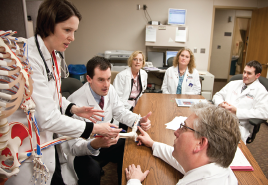
Dr. Amy C. Cannella is a dedicated instructor of the rheumatology fellows in the University of Nebraska Division of Rheumatology & Immunology.
RAIN set the bar for community-based trial participation and low cost—Dr. O’Dell estimates the initial study cost $30,000–40,000—and the model has since been expanded to other clinical trial initiatives. Having established a trial infrastructure with the Veterans Administration, the division has grown its clinical trials. The recently published RACAT trial was a $20 million trial and was conducted in cooperation with 10 RAIN sites, 18 hospitals in the VA Cooperative Studies Program and eight Canadian centers.2
Dr. Mikuls, who is co-director of the Omaha VA RA/DMARD Clinic and principal investigator (PI) for the Nebraska Arthritis Outcomes Research Center (NAORC), has served as the PI for the multi-center Veterans Affairs Rheumatoid Arthritis (VARA) registry since its inception in 2003. The VARA includes more than 2,600 veteran patients from 13 VA centers.
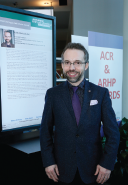
Dr. Kaleb Michaud was the recipient of the 2016 AHRP Distinguished Scholar Award.
Serum, plasma and DNA samples are collected when patients meet ACR classification criteria for RA, give informed consent and are banked in a central biorepository housed at the Nebraska Western-Iowa VA Health Care System in Omaha. Studies (more than 60 publications since 2007) drawing upon this repository have produced a wealth of insights about the largely male older population of veterans, “a unique population which many think of as being atypical of people with rheumatoid arthritis,” Dr. Mikuls says.3
Dr. Mikuls is also working with the recently launched gout trial, also a VA Cooperative Study trial, which promises to be, says Dr. O’Dell, “the world’s largest gout trial ever done.”
Epidemiologist Kaleb Michaud, PhD, associate professor, Internal Medicine, Division of Rheumatology, is now PI of the RAIN database. He joined the division in 2007 after working with the renowned Fred Wolfe, founder of the National Data Bank for Rheumatic Diseases (NDB). Originally trained as a physicist, Dr. Michaud discovered his interest in rheumatology in 2001 when he took a break from grad school to work with Dr. Wolfe. Winner of an ARHP Distinguished Scholar Award in 2016, Dr. Michaud continues his work with the NDB as co-director, while also steering the Arthritis Internet Registry, which he founded in 2010.
He says he chose to join the division because the faculty “made it clear that they care about how patients do. Dr. O’Dell always emphasizes the whole patient picture and that patients are human and have other aspects of their lives that influence their health, including financial issues.”
Of the wealth of patient data now in biorepositories, Dr. Michaud says, “We have more data than we know what to do with. We are always looking for collaborations, and we are committed to sharing our data.”
Amy C. Cannella, MD, MS, associate professor, Division of Rheumatology, and director of the Rheumatology Fellowship Program, adds, “We have a strong community alliance for our patients and also the other physicians of Nebraska. They, in turn, have been wonderful in helping us accomplish our research mission.”
The Teaching Mission
Several of the faculty we interviewed professed a special passion for rheumatology, an enthusiasm initially sparked during their own training at UNMC. Dr. Cannella recalls that she was “hooked on my first day of my third year of medical school, and they reeled me in. They [the rheumatology faculty] were such great teachers, and I was amazed by their enthusiasm for their content, their patients and their commitment to me as a learner,” she says.
Before she signed on as a faculty member, Dr. Cannella worked in private practice and in two other academic settings. She is currently on the oversight committee to restructure the medical school curriculum and is responsible for the redesign of the five-week musculoskeletal and dermatology block.
Dr. Cannella is also committed to the use of musculoskeletal ultrasound (MSUS) as a teaching tool for medical students and for the delivery of clinical care for rheumatology patients. She is an advocate for MSUS in fellow education, is a member and instructor for the Ultrasound School of North American Rheumatologists (USSONAR) and is chairing the ACR MSUS fellow curriculum development. The culture of the division, she says, “fosters support for faculty education initiatives across the board, and little has changed in the commitment to education since I was a student.”
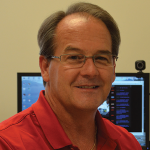
Dr. Geoffrey M. Thiele
Geoffrey M.Thiele, PhD, wears many hats in the division, and his career is emblematic of its dedication to excellence in teaching. Originally hired in 1985 by Dr. Klassen after attaining his doctorate in microbiology/immunology, Dr. Thiele began what has now grown to a 30-year collaboration with the division founder. Dr. Klassen started the bone marrow transplant center and initiated the Experimental Immunology Laboratory, which Dr. Thiele now directs. He saw the opportunity to work with Dr. Klassen and the burgeoning division as an “incredible opportunity.”
Working with the large VA population in Omaha, their original collaborations focused on the autoimmune components of alcoholic liver disease. In addition to continuing work on the effects of altered self-proteins on the immune response, Dr. Thiele is currently a professor in internal medicine and co-director with Dr. Mikuls of the VARA biobank.4 He is also in charge of revisions to the immunology aspects of the new curriculum, working with Dr. Cannella and others on the committee to restructure the UNMC medical school curriculum.
Dr. Thiele is attuned to the changing needs of student learners and wrestles with new modalities to teach and assess students’ understanding and application of basic immunological principles. His efforts must be resonating: He has been recognized every year since 1995 for excellence in teaching by the Department of Internal Medicine’s Education Committee, and by the College of Medicine with multiple teaching awards. He modestly brushes aside the accolades—“the rumors are I do it [teach] okay.”
As with the other faculty with whom we spoke, Dr. Thiele has the greatest regard for his colleagues. “I love being here. I don’t ever want to leave,” he says.
Building More Capacity
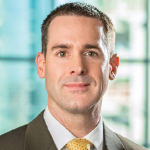
Dr. Michael G. Feely
Like Dr. Cannella, Marcus H. Snow, MD, spent time in private practice following his training and before joining the division faculty. An assistant professor of internal medicine since 2015, Dr. Snow has developed a scleroderma clinic with the encouragement of Dr. O’Dell.
“I think my time in private practice gave me some perspective,” he reflects. In addition to the role models provided by Drs. Moore and Klassen, Dr. Snow appreciates Dr. O’Dell’s leadership style. “We [he and his faculty colleagues] tend to be internally motivated here. I’ve transitioned from resident to fellow to faculty, and I realize how lucky I am. Jim [Dr. O’Dell] provides long-term guidance, but he doesn’t micromanage.”
Michael G. Feely, MD, assistant professor of medicine, was initially drawn to the rheumatology program by its emphasis on “education above everything else,” he says. He completed his fellowship in 2010, and is now director of the Clinic for Inflammatory Myopathies, located in a freestanding multispecialty clinic under the Nebraska Medical Center in West Omaha. He also contributes to research activities through the RAIN and VARA biobanks, collecting serum samples on his patients who have inflammatory myopathies.
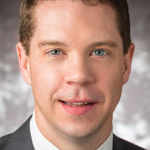
Dr. Marcus H. Snow
The emphasis on education has paid off, in large part due to the strategic placement of rheumatologists in the university system, according to Dr. O’Dell, who received an ACR Distinguished Clinical Investigator Award in 2016. Each year for the past 25, the division has successfully trained one rheumatologist in 25 residents, an average that ranks among the very best in the nation.
Dr. O’Dell and other senior faculty clearly manage to convey the passion they feel for their specialty to residents. That was the case for Steven Craig, MD, who is with the Iowa Arthritis and Osteoporosis Center, a 12-provider single-specialty private practice in Urbandale, Iowa, serving the Greater Des Moines and surrounding areas. He was part of the second class of fellows from the program that began in 2006–2007.

Dr. Steven Craig
“What captured me,” he says, “is that you get the privilege of being a specialist while maintaining the best parts of being a primary care physician; there is no question that my favorite part of the job is the proverbial continuity of care. I am eight years out from leaving my fellowship, and I’ve grown close to people I initially saw in those first few months of starting practice.
“I’m eternally grateful to all of the folks who were part of the program in training me. I felt well qualified and very confident coming out of fellowship—although, like medicine in general, rheumatology will continue to teach a dose of humility when necessary.”
Gretchen Henkel is a medical journalist based in California.
References
- O’Dell JR, Haire CE, Erikson N, et al. Treatment of rheumatoid arthritis with methotrexate alone, sulfasalazine and hydroxychloroquine, or a combination of all three medications. N Engl J Med. 1996 May 16;334(20):1287–1291.
- O’Dell JR, Mikuls TR, Taylor TH, et al. Therapies for active rheumatoid arthritis after methotrexate failure. N Engl J Med. 2013 Jul 15;369(4):307–318.
- England BR, Sayles H1, Michaud K, et al. Cause-specific mortality in male US veterans with rheumatoid arthritis. Arthritis Care Res (Hoboken). 2016 Jan;68(1):36–45.
- Sokolove J, Johnson DS, Lahey LJ, et al. Rheumatoid factor as a potentiator of anti-citrullinated protein antibody mediated inflammation in rheumatoid arthritis. Arthritis Rheumatol. 2014 Apr 1;66(4):813–821.



